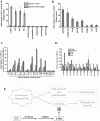Cytochrome P450 1A2 Metabolizes 17β-Estradiol to Suppress Hepatocellular Carcinoma
- PMID: 27093553
- PMCID: PMC4836701
- DOI: 10.1371/journal.pone.0153863
Cytochrome P450 1A2 Metabolizes 17β-Estradiol to Suppress Hepatocellular Carcinoma
Abstract
Hepatocellular carcinoma (HCC) occurs more frequently in men than in women. It is commonly agreed that estrogen plays important roles in suppressing HCC development, however, the underlying mechanism remains largely unknown. Since estrogen is mainly metabolized in liver and its metabolites affect cell proliferation, we sought to investigate if the liver-specific cytochrome P450 1A2 (CYP1A2) mediated the inhibitory effect of estrogen on HCC. In this study, the expression of estrogen-metabolizing enzyme CYP1A2 was determined in HCC tissues and cell lines. Cell proliferation and apoptosis were assessed in cells with or without CYP1A2 overexpression. The levels of 17β-estradiol (E2) and its metabolite 2-methoxyestradiol (2-ME) were determined. A xenograft tumor model in mice was established to confirm the findings. It was found that CYP1A2 expression was greatly repressed in HCC. E2 suppressed HCC cell proliferation and xenograft tumor development by inducing apoptosis. The inhibitory effect was significantly enhanced in cells with CYP1A2 overexpression, which effectively conversed E2 to the cytotoxic 2-ME. E2 in combination with sorafenib showed an additive effect on HCC. The anti-HCC effect of E2 was not associated with estrogen receptors ERα and ERβ as well as tumor suppressor P53 but enhanced by the approved anti-HCC drug sorafenib. In addition, HDAC inhibitors greatly induced CYP1A2 promoter activities in cancer cells, especially liver cancer cells, but not in non-tumorigenic cells. Collectively, CYP1A2 metabolizes E2 to generate the potent anti-tumor agent 2-ME in HCC. The reduction of CYP1A2 significantly disrupts this metabolic pathway, contributing the progression and growth of HCC and the gender disparity of this malignancy.
Conflict of interest statement
Figures





Similar articles
-
Sorafenib inhibits proliferation and invasion of human hepatocellular carcinoma cells via up-regulation of p53 and suppressing FoxM1.Acta Pharmacol Sin. 2015 Feb;36(2):241-51. doi: 10.1038/aps.2014.122. Epub 2015 Jan 5. Acta Pharmacol Sin. 2015. PMID: 25557114 Free PMC article.
-
2-Methoxyestradiol synergizes with sorafenib to suppress hepatocellular carcinoma by simultaneously dysregulating hypoxia-inducible factor-1 and -2.Cancer Lett. 2014 Dec 1;355(1):96-105. doi: 10.1016/j.canlet.2014.09.011. Epub 2014 Sep 11. Cancer Lett. 2014. PMID: 25218350
-
The retinoblastoma (Rb) protein regulates ferroptosis induced by sorafenib in human hepatocellular carcinoma cells.Cancer Lett. 2015 Jan 28;356(2 Pt B):971-7. doi: 10.1016/j.canlet.2014.11.014. Epub 2014 Nov 12. Cancer Lett. 2015. PMID: 25444922
-
Estrogen receptors and the metabolic network.Cell Metab. 2011 Sep 7;14(3):289-99. doi: 10.1016/j.cmet.2011.08.005. Cell Metab. 2011. PMID: 21907136 Review.
-
Role of sex steroid receptors in pathobiology of hepatocellular carcinoma.World J Gastroenterol. 2008 Oct 21;14(39):5945-61. doi: 10.3748/wjg.14.5945. World J Gastroenterol. 2008. PMID: 18932272 Free PMC article. Review.
Cited by
-
Alcohol and hepatocellular carcinoma.BMJ Open Gastroenterol. 2019 Apr 3;6(1):e000260. doi: 10.1136/bmjgast-2018-000260. eCollection 2019. BMJ Open Gastroenterol. 2019. PMID: 31139422 Free PMC article. Review.
-
Estrogen Receptor-α Suppresses Liver Carcinogenesis and Establishes Sex-Specific Gene Expression.Cancers (Basel). 2021 May 13;13(10):2355. doi: 10.3390/cancers13102355. Cancers (Basel). 2021. PMID: 34068249 Free PMC article.
-
The dual role of transforming growth factor-beta signatures in human B viral multistep hepatocarcinogenesis: early and late responsive genes.J Liver Cancer. 2022 Sep;22(2):115-124. doi: 10.17998/jlc.2022.04.20. Epub 2022 May 20. J Liver Cancer. 2022. PMID: 37383409 Free PMC article.
-
Sex difference in human diseases: mechanistic insights and clinical implications.Signal Transduct Target Ther. 2024 Sep 10;9(1):238. doi: 10.1038/s41392-024-01929-7. Signal Transduct Target Ther. 2024. PMID: 39256355 Free PMC article. Review.
-
Cytochrome P450: Polymorphisms and Roles in Cancer, Diabetes and Atherosclerosis.Asian Pac J Cancer Prev. 2018 Aug 24;19(8):2057-2070. doi: 10.22034/APJCP.2018.19.8.2057. Asian Pac J Cancer Prev. 2018. PMID: 30139042 Free PMC article. Review.
References
-
- Park SJ, Jeong SY, Kim HJ. Y chromosome loss and other genomic alterations in hepatocellular carcinoma cell lines analyzed by CGH and CGH array. Cancer Genet Cytogenet. 2006;166: 56–64. - PubMed
-
- Liu J, Wang ZM, Zhen SF, Wu XP, Ma DX, Li ZH, et al. Aberration of X chromosome in liver neoplasm detected by fluorescence in situ hybridization. Hepatobiliary Pancreat Dis Int. 2004;3: 110–114 - PubMed
Publication types
MeSH terms
Substances
LinkOut - more resources
Full Text Sources
Other Literature Sources
Medical
Research Materials
Miscellaneous

